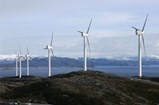GE's Offshore Technology Expands With ScanWind Buy

As part of its push into the expanding offshore wind sector, GE Energy announced recently that it has completed the acquisition of ScanWind, the maker of an advanced turbine drive train technology that eliminates the need for gearboxes. It's a critical advantage to have in the offshore wind industry, where reliability is parmount due to harsh environments and the high maintenance costs that result when the only way to service turbines is by boat.
Noting that the deal marks GE's "first large-scale move into offshore wind power," the Financial Times calls it "a vote of confidence in the fledgling offshore wind industry, which has been plagued by concerns about costs and reliability." The paper goes on to report that "most industry experts believe a huge expansion of offshore wind will be needed for the European Union to hit its target of deriving 20 percent of its energy from renewable sources by 2020." Analyst expectations are for a 20-fold increase from a globally installed base of 1.5 gigawatts in 2008 to 30 GW by 2020.
The announcement was made at the European Offshore Wind Conference in Stockholm, where Vic Abate, who heads GE's Renewable Energy business, said the move underscores GE's commitment to continue to invest in innovative new technologies, even in the midst of the toughest economic climate in decades. "GE's overall strategy is to ensure that we're the innovation leader by developing new renewable energy technologies, collaborating with key players, and when appropriate, making key acquisitions," he said.
ScanWind's turbine technology will join GE's family of wind turbines that includes the GE 1.5-megawatt series, the most widely deployed wind turbine in the world with more than 12,000 now in operation. In a traditional turbine design, a rotor and a gearbox connect to a generator — and it's essential that the gearbox be able to handle high loads. Turbines with bigger outputs of electricity, like offshore turbines, have even bigger loads — which makes reliability of that gearbox even more of a challenge. Direct drive technology, such as that developed by ScanWind, takes the rotor and connects it directly to a generator that is designed to operate at low speeds creating a simple, solid, reliable drive train design.
The possibility of mass producing ScanWind's technology couldn't come at a better time. As Reuters notes in its coverage of the wind conference, the wind industry association says "offshore wind turbines could meet 13-17 percent of Europe's electricity need in 2030 if wind power projects get sufficient support."
SOURCE: GE Energy
